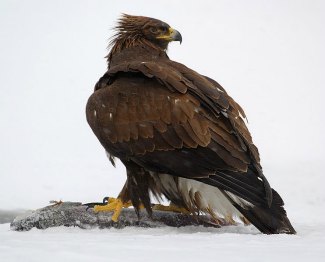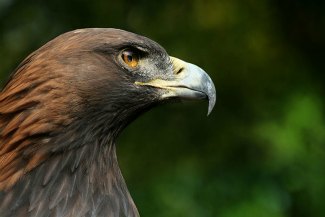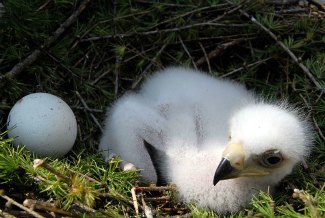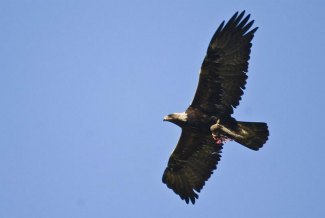Golden Eagle - Aquila chrysaetos
By Игорь Шпиленок, CC-BY-3.0, via Wikimedia Commons
Family: Accipitridae
Genus: Aquila
Species: A. chrysaetos
Subspecies: A. c. canadensis, A. c. chrysaetos, A. c. daphanea, A. c. homeyeri, A. c. japonica, A. c. kamtschatica
Golden Eagles are large, powerful raptors that live across several continents in a range of open habitats. They form a clade with Aquila africana (Cassin’s Hawk Eagle), A. audax (Wedge-Tailed Eagle) A. fasciata (Bonelli’s Eagle), A. gurneyi (Gurney’s Eagle), and A. verreauxii (Verreaux’s Eagle).
Physical Description:
Golden Eagles have a dark brown body and a light-brown head and neck. The flight feathers and underwing coverts are dark gray, and the tail has a gray to black terminal band. The beak is blue-gray with a black tip, and the cere and gape-flange—where the upper and lower mandibles meet—are yellow. Eyes are yellow-brown and the feet are yellow with black talons 4-6 cm long. The legs are feathered. The wings are long and broad and held in a shallow "V" when flying. The head is small compared to the length of the tail and the body.
Juveniles are brown like adults, but they have white patches at the base of the tail and along the wings. They reach full adult plumage and are sexually mature after 4-5 years, though it can take up to nine years in northern areas of Eurasia.
Golden Eagles are quiet birds, and when they do call, it is a thin and weak sound—though it can carry up to 1.5 km. Listen to a recording.
They can live up to 32 years in the wild. Captive eagles have lived to 57 years.
Size:
Length: 80-93 cm
Wingspan: 190-225 cm
Weight: Male: 2.8-4.6 kg. Female: 3.6-6.7 kg.
Habitat and Distribution:
They are found in a range of habitats, both mountainous or flat, including deserts, steppes, tundra, grasslands, coniferous forests, wetlands, and along rivers and streams. They prefer areas with cliffs and forests that alternate with open space.
By Richard Bartz, CC-BY-SA-2.5, via Wikimedia Commons
Golden Eagles live from northern Eurasia and Siberia down to northern Africa, the Mediterranean, and the Middle East.They are also found across Pakistan, China, Korea, and Japan. They inhabit North America from Alaska and Canada east to Labrador, and south in the western part of the continent to central Mexico. Their total range spans from 70°N to 20°N. They live from 0-4,000 meters above sea level, up to 5,500 m in the Himalayas. Northern populations above 65°N are migratory and nomadic behavior and altitudinal migration has been recorded, though Golden Eagles are mostly sedentary. Juveniles disperse from breeding areas, females usually traveling further from the nest than males.
There are an estimated 170,000 individuals over a range of 41,400,000 km².
Diet and Hunting:
They eat a range of prey, ranging from smaller mammals such as ground squirrels and rabbits to foxes, deer, and goats. They take a range of birds as prey including pheasants and grouses to small raptors and swans. The rest of their diet includes reptiles, amphibians, fish, and carrion. In addition, they are known to hunt tortoises, dropping them onto rocks from some height to crack the shells open. During the winter they will eat large amounts of carrion.
They hunt by soaring, flying low over an area, or still-hunting on a perch. They dive at speeds up to 241 kilometers per hour to catch their prey, and take animals as heavy as 6 kg. Birds are sometimes caught mid-flight, though they catch most of food on the ground. Golden Eagles occasionally hunt in pairs or small groups. In parts of Eurasia, they are used by people to kill wolves.
Despite their diet, however, and contrary to a belief that resulted in the deaths of thousands of Golden Eagles, they do not pose a significant threat to sheep.
By Johann Jaritz, CC-BY-SA-3.0, via Wikimedia Commons
Reproduction:
Breeding displays are performed by both males and females, in the form of steep plunges and soars upwards, and claw-grappling. The breeding season varies across their range, from March-April in most regions, December-January in the south, and April-May in the northernmost areas. Pairs mate for life and maintain territories up to 155 km².
The nest is made out of sticks and lined with green leaves, wool, grasses, and other natural material. It is placed in a tree or on a cliff or electricity pylon, 3-30 meters above the ground. Nests are sometimes used year after year, though a pair may have as many as 10-12 nests and use them in rotation. The usual dimensions of a nest are around 1.5 m wide and 2 m deep; one of the largest recorded was 6 meters deep. 1-3 eggs are laid, usually 2 and extremely rarely 4, and are incubated for 41-45 days by both parents. The female does most of the incubating. Siblicide—or Cainism—is common, and two chicks are raised as rarely as every fourth brood; three chicks have fledged in a few very rare cases. Fledging takes 60-85 days, though young remain dependent on the parents for 2.5-4 months.
Conservation:
Golden Eagles are widely distributed but the population is declining in some areas, including parts of the USA. In regions where they are threatened the threats are habitat loss, shooting, trapping, poisoning, disturbance, collision with power lines, electrocution, and illegal trade. However, despite these there are still healthy populations in some of their range. They are listed as Least Concern by BirdLife International.
Golden Eagles are protected in the UK by the Wildlife and Countryside Act, 1981 and are listed as a UK Species of Conservation Importance and a Species of European Concern. They are recognized as an endangered species in the states of Maine, New Hampshire, and New York, and a Species of Special Concern in Washington and Montana. It is federally protected in the USA under the Bald and Golden Eagle Protection Act of 1962.
By Chuck Abbe, CC-BY-2.0, via Wikimedia Commons/ Flickr
Taxonomy:
Species Aquila chrysaetos, Aquila africana (Cassin’s Hawk Eagle), A. audax (Wedge-Tailed Eagle) A. fasciata (Bonelli’s Eagle), A. gurneyi (Gurney’s Eagle), and A. verreauxii (Verreaux’s Eagle) form a clade.
The scientific name Aquila chrysaetos comes from the Latin word aquila for "eagle", the Greek khrysos which means "golden", and the Greek aetos, which also means "eagle".
Subspecies:
There are six subspecies: A. c. canadensis lives in North America from Alaska to northern Mexico and east to Labrador, Quebec, and New York; A. c. chrysaetos in northwestern and central Europe, and western and central Siberia; A. c. daphanea in the Middle East from Iran and the Himalayas to Pakistan, northeastern China, and southwestern China; A. c. homeyeri in the Iberian Peninsula, northwestern Africa, Mediterranean islands, and throughout the Middle East to Iran; A. c. japonica in Korea and Japan; and A. c. kamtschatica in Russia Far East and northern Mongolia.
Other Names:
American Golden Eagle, Black Eagle, Mountain Eagle, Skalen orel (Bulgarian), Orel skalní (Czech), Kongeørn (Danish), Steenarend (Dutch), Kaljukotk maakotkas (Estonian), Kotka (Finnish), Aigle Royal (French), Steinadler (German), Iolar Firéale (Irish), Aquila reale (Italian), Inuwashi (Japanese), Kilnusis erelis (Lithuanian), Fjellørn (Norwegian), Águila Real (Spanish), Eryr aur (Welsh).
Heraldry:
Golden Eagles are the national bird of Kazakhstan and Scotland. They are a central figure in Romania’s and Mexico’s Coat of Arms.
Video of a Golden Eagle:
References:
http://www.allaboutbirds.org/guide/Golden_Eagle/id
http://animals.nationalgeographic.com/animals/birds/golden-eagle/
http://www.arkive.org/golden-eagle/aquila-chrysaetos/
http://avibase.bsc-eoc.org/species.jsp?avibaseid=5F8E7CA845BD413F
BirdLife International (2011) Species factsheet: Aquila chrysaetos. Downloaded from http://www.birdlife.org on 29/11/2011.
http://www.birds.cornell.edu/BOW/goleag/
http://crib.mae.ro/index.php?lang=en&id=2299
http://www.dec.ny.gov/animals/7096.html
http://www.europeanraptors.org/raptors/golden_eagle.html
http://www.fs.fed.us/database/feis/animals/bird/aqch/all.html
Global Raptor Information Network. 2011. Species account: Golden Eagle Aquila chrysaetos. Downloaded from
http://www.globalraptors.org on 29 Nov. 2011
BirdLife International 2009. Aquila chrysaetos. In: IUCN 2011. IUCN Red List of Threatened Species. Version 2011.2.
www.iucnredlist.org. Downloaded on 29 November 2011.
http://www.peregrinefund.org/subsites/explore-raptors-2001/eagles/goldeagl.html
Ferguson-Lees, James, and Christie, David A. Raptors of the World. Houghton Mifflin Company, 2001.
http://www.scotsman.com/news/scottish-news/edinburgh-east-fife/golden_eagle_is_our_national_bird_1_551020
http://www.scottishwildlifetrust.org.uk/visit/wildlife/g/golden-eagle/



